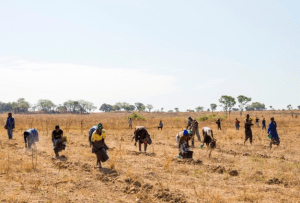

ZIMBABWE is eyeing 250 million kilogrammes of tobacco output next year, as the southern African country continues to bank on the golden leaf to turn around its economic fortunes despite growing global calls for a ban on cigarette smoking.
For most developing countries like Zimbabwe, growth in tobacco production has led to massive deforestation as farmers chop trees to cure the cash crop.
This has raised the ire of some climatologists and environmentalists prompting some governments to come up with several measures to mitigate the effects of climate change amid growing global calls for a ban on cigarette smoking.

The Sustainable Afforestation Association of Zimbabwe team dry planting in July
It is estimated that Zimbabwe loses about 300 000 hectares of indigenous forests annually due to indiscriminate cutting down of trees and 12 to 15 percent of this figure is attributed to tobacco curing.
Founded in 2013, the Sustainable Afforestation Association of Zimbabwe (SAA) is one of several initiatives intended to reduce the impact of tobacco cultivation on the country’s forests.
To date, the organisation has planted 22 000 hectares of land into forests through eucalyptus plantations in tobacco growing areas as part of its mandate of developing sustainable energy options for tobacco curing.
The SAA is targeting to have 25 000 hectares of plantation under management by the end of this year as part of efforts to curb deforestation and land degradation across the country.
“SAA’s business model to establish fuelwood plantations involves identification of land in or near the major tobacco growing regions of Manicaland and Mashonaland regions and entering into joint venture agreements (JVs) with farmers who are willing to commit to the JV for a minimum of three growth cycles, a period of approximately 20 years depending on growth rates as influenced by weather and soil fertility,” SAA operations manager Lenin Maunganidze told The Financial Gazette.
He noted that the sustainability of the tobacco industry lies in the availability of sustainable sources of energy to cure the golden leaf, which requires an average of eight to 10 kilogrammes of wood for every kilogramme of tobacco cured.
Under the Tobacco Value Chain Transformation Plan, Zimbabwe aims at increasing the current tobacco record production of 252 million kilogrammes in 2019 season to 300 million kilogrammes by 2025, which entails a three billion kilogrammes of curing wood.
“Most of the tobacco is produced by smallholder farmers who rely on wood for curing their tobacco, most of which is taken from indigenous woodlands, leading to massive deforestation. Statutory Instrument 116 of 2012, requires that for every hectare of tobacco, the farmer must establish at least 0,3 hectares of trees for future curing of his/her tobacco but very little is being done to enforce compliance,” Maunganidze said.
He said SAA’s greatest challenge in its afforestation programme was securing land to expand the programme.

“If Zimbabwe were to rely solely on plantation wood resources, an annual planting target of 25 000 to 40 000 hectares of land would be required to cure the tobacco crop. Currently, SAA has an annual planting capacity of about 3 500 hectares, which it struggles to mobilise. It is imperative that government through inter-ministerial collaboration assists in identifying potential land that could be availed to produce fuelwood for curing the national golden leaf,” Maunganidze said.
He believes the Lands ministry needs to work closely with the Environment ministry to find land for afforestation in order to achieve its Tobacco Value Chain Transformation Plan.
He called for the enforcement of the current environmental laws to curb deforestation and fire damage, which will encourage the regeneration of national forests.
“Tobacco is a strategic crop, which requires effective strategies for it to continue playing a pivotal role in Zimbabwe’s socio-economic development. We all have a responsibility to leave a sound economic foundation for future generations. SAA urges everyone to actively participate in the call for the development of the ‘Green Revolution in Zimbabwe’ in order to ensure sustainable tobacco production,” he added.
Earlier this year, the Tobacco Industry and Marketing Board said it was seeking gas technology companies to partner with in establishing a centralised gas curing facility for tobacco, a move aimed at curbing the use of firewood.
Environment minister Mangaliso Ndlovu called for active stakeholder participation in restoration programmes and climate change mitigation intervention as a means to enhance contributions towards sustainable development and achieving net zero emissions from all production sectors by 2030.
 According to the National Development Strategy 1, the objective under improved biodiversity is to increase the planted area from 11 500 hectares to 45 000 hectares by 2025 and to increase the national forest cover from 44,5 percent in 2020 to 47 percent by 2025.
According to the National Development Strategy 1, the objective under improved biodiversity is to increase the planted area from 11 500 hectares to 45 000 hectares by 2025 and to increase the national forest cover from 44,5 percent in 2020 to 47 percent by 2025.
Sustainable forest management is part of the African Green Stimulus Programme’s key elements of enhancing climate action which supports the implementation of climate change programmes.
Expanding forest conservation is key in the programme ― and calls on countries to support the implementation of climate change initiatives ― after noting that Africa’s forest area is shrinking at an alarming rate, due to illegal logging and harvesting of forest species.
“Support for African countries to achieve significant reduction in deforestation rates, while enhancing agricultural productivity, biodiversity conservation, sustainable management of natural resources and income of small-scale food and forest producers is required,” the Africa Green Stimulus said.
An overview of forest resources in Zimbabwe by the Forestry Commission shows that the country has a total natural forest area of 18,351 million hectares, which is about 46 percent of the total land area.
The commission said the area of forest continues to decline, and the country lost approximately 6,5 million hectares for the period 1992 to 2017.
President Emmerson Mnangagwa said the country was in the process of coming up with an ambitious yet achievable target to restore degraded forest areas under the African Forest Landscape Restoration 100 initiative, by 2030.
The African Forest Landscape Restoration Initiative is a country-led effort to bring 100 million hectares of land in Africa into restoration by 2030. newsdesk@fingaz.co.zw